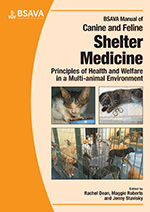
Full text loading...

Diarrhoea is a common presentation in dog shelters, and can range from occasional low-level ‘grumbling’ problems to outbreaks with high mortality. This chapter explores the management of diarrhoea, with consideration of morbidity levels, aetiology, environmental management and the potential for cross-species transmission, including zoonosis. Case examples: Parvovirus at the local rehoming shelter; Rehoming a Campylobacter-positive dog.
Diarrhoea in the dog in the shelter environment, Page 1 of 1
< Previous page | Next page > /docserver/preview/fulltext/10.22233/9781910443330/9781910443330.12-1.gif

Full text loading...











